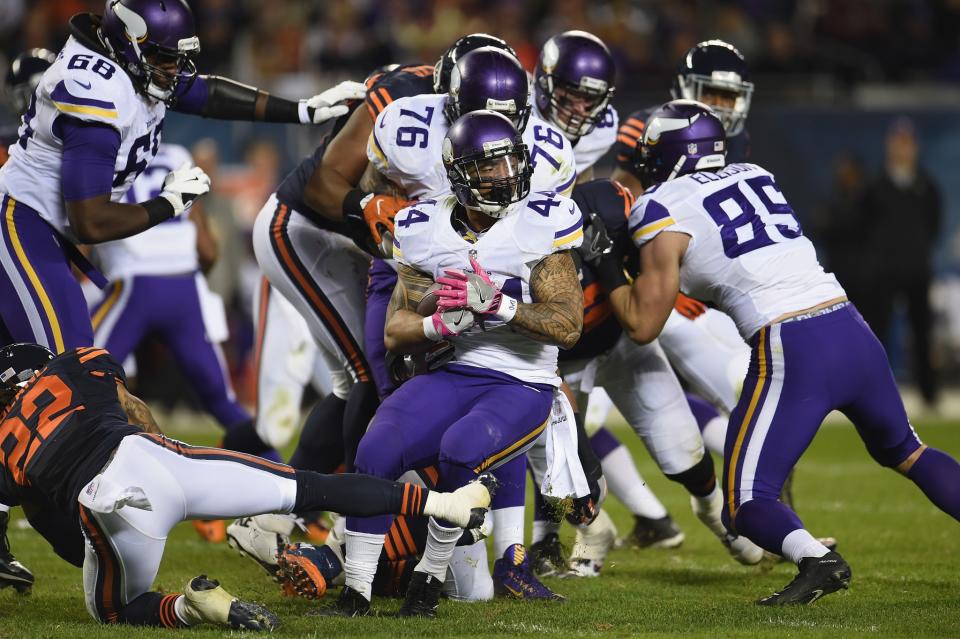Vikings run game is historically bad, but how much does that really matter?
While reading Frank Schwab’s power rankings this week, we were shocked when arriving at one incredible statistic he dug up: The Minnesota Vikings currently have the worst rushing average of any team since — wait for it — the 1953 New York Giants.
This season, the Vikings are averaging a paltry 2.7 yards per carry. Their longest run this season has been 29 yards. Adrian Peterson, prior to the injury that landed him on IR, actually hurt the team’s average with 31 rushes for 50 yards (1.9 yards per carry).
On the surface, this is stunning and rightfully concerning. Prior to a three-game losing streak, the Vikings were 5-0 and being discussed among the NFL’s elite. Is this, amid the resignation of offensive coordinator Norv Turner, going to be the Achilles heel that takes the Vikings out of contention?

[Play our $125K Baller | Free Yahoo Cup entry | Tips for your Daily lineup]
Maybe. History says it might not doom them, but we also get a clear picture of the limitations of teams that can’t run the ball.
First, let’s narrow the search a bit and just look at teams since the NFL-AFL merger of 1970. Since then, seven teams have averaged fewer than 3.05 yards per carry, according to Pro Football Reference. Amazingly, of those seven, six had a record of .500 or better.
Granted, the most recent of those teams — the 2000 San Diego Chargers — were 1-15, losers of their first 11 games of the season. But that was just a bad football team that started four different quarterbacks that season (including Jim Harbaugh and Ryan Leaf … oral history material?) and whose leading rushers were Jermaine Fazande, Terrell Fletcher and Robert Chancey — none of whom started another NFL game after that season.
The Chargers won their lone game by a single point. They upgraded the position slightly the following year. Some guy named LaDainian Tomlinson was their new starter, and the team’s rushing average went up nearly a whole yard per carry.
Now let’s narrow the worst-rushing team search a bit more and look at the ones since the start of 2001. This is where we see a bit more concern as it relates to the 2016 Vikings. Of the bottom seven teams to complete a full season, all of which averaged 3.26 yards per carry or less, none had a record better than .500 — quite the contrast from the larger sample size including the previous 20 seasons.
However, did you notice? The list contains a whopping four teams from this season — the Vikings, New York Giants (3.19), Seattle Seahawks (3.21) and Los Angeles Rams (3.22). What’s interesting is that the first three teams are all 5-3 or better and the Rams sit at 3-5; none are out of the playoff race.
So armed with that conflicting data, can we say the Vikings can make the playoffs — and make a run — if the run game doesn’t improve significantly? Two recent teams, the 2014 Arizona Cardinals and 2009 Chargers, won 11 and 13 games, respectively, averaging 3.33 yards per carry or less. Both lost in their first playoff games, however, but the Cardinals did so with Ryan Lindley at QB against the Carolina Panthers. The Chargers, however, did nothing on the ground with Darren Sproles and a beat-up Tomlinson and were bounced by the New York Jets.
But let’s use that 3.33 number as a benchmark for the Vikings. And let’s assume, for symmetry’s sake, they run the ball in the second half of the season the same number of times (214) that they ran it in the first half. That would require the Vikings to boost their per-carry average by more than a yard — 3.94 yards per carry. Not knowing if Peterson can return (or do much upon his return) or if the offensive line can make drastic improvements under new play caller Pat Shurmur, that’s asking quite a bit. This is less about avoiding ignominy and more about creating some semblance of balance offensively.
Still left on the team’s schedule are four games against top-10 run teams — all four of which allow fewer than our target of 3.94 yards per carry:
at Washington Redskins (4.85 yards per carry allowed, ranked 31st)
vs. Arizona Cardinals (3.85, 9th)
at Detroit Lions (4.30, 20th)
vs. Dallas Cowboys (4.24, 19th)
at Jacksonville Jaguars (4.01, 12th)
vs. Indianapolis Colts (4.66, 28th)
at Green Bay Packers (3.29, 2nd)
vs. Chicago Bears (3.88, 10th)
But the other four allow 4.24 yards per carry or more, which clearly presents some opportunities. For what it’s worth, these eight teams collectively have allowed 4.15 yards per carry. Still, it’s not as if the Vikings have done anything recently to prove they’re capable of making a big jump. In the three losses, they’ve averaged 3.4, 3.2 and 3.1 yards per carry in scoring 10, 10 and 16 points.
So whether it’s a healthier Jerick McKinnon, a more integrated Ronnie Hillman, a more effective Matt Asiata or — long shot here — a return by Peterson, the Vikings are going to need to find solutions from within to change this historically bad run game. And as we said above, the troubles along the offensive line, losing multiple starters this season, clearly has played a big role. Otherwise, their ceiling appears lower than we thought a month ago.
– – – – – – –
Eric Edholm is a writer for Shutdown Corner on Yahoo Sports. Have a tip? Email him at edholm@yahoo-inc.com or follow him on Twitter!


